 |
MASTER of Saint Gilles -- Click Here
|
|
French Painter, active ca.1500 |
|
 |
Master of Saint Giles -- Click Here
|
|
The Master of Saint Giles (French: Maître de Saint-Gilles) was a Franco-Flemish painter active, probably in Paris, about 1500, working in a delicate Late Gothic manner, with rendering of textures and light and faithful depictions of actual interiors that show his affinities with Netherlandish painting. It is not clear whether the Master of Saint Giles was a French painter who trained in the Low Countries (perhaps more likely), or a Netherlander who emigrated to France.
His pseudonym was given him by Max Friedländer, who reconstructed part of the anonymous painter's oeuvre, starting from two panels devoted to Saint Giles (a Miracle and a Mass) in the National Gallery, London, that were part of the lefthand shutter of an altarpiece, and two further panels now in Washington from the same altarpiece. The hand of an assistant can be discerned in the Baptism of Clovis at the National Gallery of Art, Washington, who also have a panel with Episodes from the Life of a Bishop-Saint - perhaps Saint Leu, Saint Denis or Saint Remy. All four panels have, or had, single grisaille figures of saints (Saints Peter, Giles, Denis and an unidentified bishop-saint) in niches, imitating sculpture, on the reverse. The Washington pair, which were in poor condition, have been separated and are lost, although photographs exist. Undoubtedly there were further panels, whose subjects cannot be guessed, as the combination of scenes is original. |
|
 |
MASTER of Saint Cecilia -- Click Here
|
|
Italian Byzantine Style Painter, active 1300-1320 |
|
 |
Master of Moulins -- Click Here
|
|
French
1480-1500 Master of Moulins Gallery
Until the late 20th century, the name of the painter of the Moulins Triptych was unknown, although art historians identified a number of other works that were evidently by the same hand. The first monograph on the Master of Moulins, written in 1961 by Madeleine Huillet d'Istria, argued that this artist did not actually exist, and that more than 12 different artists were responsible for the corpus of works traditionally ascribed to him. The Master's identity was established after an inscription was found on the reverse of a damaged painting, Christ with Crown of Thorns (1494) in the Royal Museums of Fine Arts of Belgium, Brussels, identifying the artist as Jean Hey, teutonicus and pictor egregius ("the famous painter"), and identifying the patron as Jean Cueillette, who was secretary to the King and an associate of the Bourbon family. Stylistic similarities link this painting to the works attributed to the Master of Moulins. The Master of Moulins appears to have been the court painter for the Bourbons, and from a surviving account for 1502-03, it is clear that the court painter's name was Jean; other candidates once considered plausible, such as Jean Perr??al and Jean Prevost, have proven untenable in the light of subsequent research. The term "Teutonicus", or "German" included Flemings at this date. |
|
 |
Master of Hoogstraeten -- Click Here
|
|
Flemish Northern Renaissance Painter, active ca.1490-1530 |
|
 |
MASTER of Hohenfurth -- Click Here
|
|
Bohemian painter
active 1350-70 in Prague
|
|
 |
MASTER of Heiligenkreuz -- Click Here
|
|
Austrian Northern Renaissance Painter, 15th Century,was an Austrian painter active at the beginning of the fifteenth century; a tentative lifespan of 1395 to 1430 has been put forth, but this appears highly conjectural. His name is taken from a diptych that once belonged to the Cistercian Abbey of Heiligenkreuz, located in southeastern Austria near the present-day border with Hungary. The left panel depicts the Annunciation on the obverse; the reverse is a depiction of the Madonna and Child. The right panel depicts the Mystical Marriage of Saint Catherine, with Saint Dorothy on its reverse. Details of costume and iconography combine with associations with the International Style to indicate a date of around the first decade of the fifteenth century.
It was initially proposed, by Betty Kurth in 1922, that the artist was French and had some association with the court in Paris. Other writers have disagreed, and various nationalities including French, Austrian, German, or Bohemian have been posited for the Master. Some have further suggested that he was an itinerant court artist, trained in France but active in Austria. Various clues have been used in an attempt to describe his nationality. These include his use of finely-worked gold decoration, in which some have seen a link to Franco-Burgundian goldsmith's work of the late fourteenth century. Others, instead, see it as a link to the school of panel painting then active at the court in Prague. Consequently, it seems highly unlikely that the artist's nationality will be conclusively established.
|
|
 |
Master of Frankfurt -- Click Here
|
|
Flemish Northern Renaissance Painter, 1460-ca.1533.South Netherlandish painter. He takes his name from two paintings commissioned by patrons from Frankfurt am Main. His chief importance lies in his continuing the great tradition of 15th-century Netherlandish painting (particularly the compositions of Rogier van der Weyden and Hugo van der Goes) well into the 16th century, his development of a markedly earthy figure type, his apparently innovative management of a large workshop that 'mass-produced' paintings for the open market and his status |
|
 |
Master Of Flemalle -- Click Here
|
|
Robert Campin (c. 1375 - 26 April 1444), now usually identified as the artist known as the Master of Flemalle, is usually considered the first great master of Flemish and Early Netherlandish painting. This had been a matter of controversy for decades; Campin's life is relatively well documented for the period, but no works in assessable condition could be securely connected with him, whilst a corpus of work had been attached to the unidentified "Master of Flemalle", named after the supposed origin of a work.
Campin seems to have had relatives in Valenciennes. He first appears as settled in Tournai from the archives of 1405-6, as a free master of the guild of painters, and he bought citizenship in 1410, which suggests he was not born there. He eventually attained the office of dean of the guild, and wardenship of a church and other civic offices, and was running a large workshop. By 1432, however, he lost his civic positions because of scandals, and probably his role in political disturbances in the city. In 1429 he was found guilty of withholding evidence, and sentenced to go on a pilgrimage, and in 1432 was convicted of adultery and banished for a year. Margaret of Burgundy, wife of the Count of Holland and sister of John the Fearless, Duke of Burgundy intervened on his behalf, and this was reduced to a fine. The dated Werl Altarpiece (1438) shows he continued to work (the two outer wings are in the Prado; the main panel is lost). |
|
 |
MASTER of Female Half-length -- Click Here
|
|
Dutch painter (active 1530-1540) |
|
 |
MASTER of Budapest -- Click Here
|
|
Spanish painter
active c. 1500 in Castile |
|
 |
Master of Avila -- Click Here
|
|
15 Master of Avila Nativity 1474-76 Oil on wood Museo Lezaro Galdiano, Madrid This is the finest work of the master, it forms part of a triptych as the central panel. The left panel was the Annunciation to the Shepherds while the right panel represented the Annunciation to the Magi. The composition follows the example of Gallego's paintings and the use of the cool colors |
|
 |
Master of Ab Monogram -- Click Here
|
|
MASTER of AB Monogram. German painter (active 1530s in Saxony |
|
|
|
 |
Master Francke -- Click Here
|
|
German painter (early 15th century, active in Hamburg). respectively German for "Master Francke" and Latin for "Brother Francke", was a North German Gothic painter and Dominican friar, born ca. 1380 in the Lower Rhine region or possibly Zutphen in the Netherlands, who died ca. 1440, probably in Hamburg, where he was based at the end of his known career. He is called "Fratre Francone Zutphanico" ("Brother Frank of Zutphen") in one document. He may have trained as an illuminator and painter in France or the Netherlands, and later worked in Munster, before joining in St John's Friary in Hamburg by 1424 at the latest.
Two main altarpieces attributed to him survive, dedicated to St Thomas of Canterbury and Saint Barbara, in an unusually intense style, showing awareness of French and Early Netherlandish court art. He probably arrived in Hamburg after the death in 1415 of the previous leading artist there, Master Bertram, and shows little or no influence from him, but he may have been influenced by the more courtly style of Conrad von Soest, about ten years older than Francke, who worked to the south in Westphalia.
The Hamburg association of traders to England commissioned an altarpiece from "Mester Francke[nn]" in 1424; the contract does not survive, but is mentioned in their memorial book. This is probably the "St Thomas (of Canterbury) Altarpiece", completed in 1436, of which parts survive in the Kunsthalle, Hamburg. The rather earlier St Barbara Altarpiece may have been commissioned for Finland, where it surfaced a century ago. The "Thomas Altar" has eight surviving scenes, but is missing its main panel and several others. The "Barbara Altar" has also eight scenes, on both sides of the wings to a carved wood central panel by another artist. At least two other panels are in museum collections. Francke was almost entirely forgotten after the Renaissance until the end of the 19th century when, like Master Bertram, he was rediscovered and published by Alfred Lichtwart, Director of the Hamburg Kunsthalle
|
|
 |
MASTER Bertram -- Click Here
|
|
German painter (b. cca. 1345, Minden, d. 1415, Hamburg).
was a German International Gothic painter primarily of religious art. His most famous surviving work is the large Grabow Altarpiece (or Petri-Altar) in the Kunsthalle Hamburg, the largest and most important North German painting of the period. There is a 45-scene altarpiece of the Apocalypse, probably by his workshop, in the Victoria and Albert Museum in London. He, or his workshop, also produced sculpture, presumably in wood; in fact in his first years in Hamburg most surviving documentation relates to sculpture, including chandeliers. He is first recorded in Hamburg in 1367, and lived there for the rest of his life, becoming a citizen and Master in 1376, and achieving considerable prosperity. In 1390 he made a will in advance of an intended pilgrimage to Rome, but if he made the journey it had no detectable influence on his art. He was married, but his wife had died by his second will in 1410, when he had a surviving daughter. His style is less emotional than that of his Hamburg near-contemporary Master Francke, but has great charm. Bertram was largely forgotten after the Renaissance until the end of the 19th century |
|
 |
MASSYS, Quentin -- Click Here
|
|
Flemish Northern Renaissance Painter, ca.1465-1530
Quentin Massys, also spelled Matsys or Metsys, was born in Louvain, the son of a blacksmith. He is traditionally thought to have been trained in that craft by his father. Art in Louvain while Massys was growing up was dominated by Dirk Bouts. Massys became a member of the painters' guild in Antwerp in 1491 and died there in 1530. He represented a current of painting that flourished in Antwerp at this time of its sudden new prosperity. Erwin Panofsky (1953) described this trend, "archaism of around 1500," as "a prelude to, in fact a fact of, the Renaissance in Netherlandish painting," which prevailed in the southern Netherlands. The monumental Enthroned Madonna (Brussels), an early work by Massys, has features recalling both Robert Campin and Jan van Eyck. The central panel of Massys' imposing St. Anne Altarpiece, or the Holy Kinship (Brussels), which was commissioned for the church of St-Pierre in Louvain in 1507 and signed and dated 1509, has a prototype in the Holy Kinship of Geertgen tot Sint Jans. Even the physical types and costumes in Massys' version refer to Geertgen's. But Massys placed his rhythmically balanced figure groups in a domed, arcaded loggia that in architectural style appears to be reaching for a Renaissance vocabulary it cannot quite attain; certainly the architecture evokes a later period than that represented by the Gothic throne of the Enthroned Madonna. The calm and restraint of the St. Anne Altarpiece are replaced by heightened emotional expression in the next important painting by Massys that can be firmly dated, the Deposition triptych (Antwerp). This was commissioned in 1508 by the guild of joiners in Antwerp for their chapel in the Cathedral; Massys completed the composition in 1511. It was inspired by Rogier van der Weyden's great Deposition, which was in the church of St-Pierre in Louvain in Massys' time, and also quotes from Rogier's Entombment. Massys painted genre subjects, possibly with emblematic meaning, such as A Money Changer and His Wife, which belonged to a Netherlandish tradition that maintained its popularity right through the 17th century. In portraiture he made significant contributions. His pair of portraits of Erasmus and Petrus Aegidius, painted in 1517 for Sir Thomas More, set the pattern for representations of the scholar in his study. |
|
 |
MASSYS, Jan -- Click Here
|
|
Netherlandish Painter, ca.1509-1575
Painter, son of Quinten Metsys. More so than his brother Cornelis Massys, who was a less talented artist, Jan worked in the style of his father, whose studio he may have taken over following his death in 1530. Two years later, though still under the age of majority, Jan was admitted as a master in the Guild of St Luke in Antwerp. Like Cornelis, he seems to have left Antwerp immediately after attaining the status of master, for he is not mentioned again in the archives. It has been suggested on stylistic grounds that he worked for a period at Fontainebleau, but this is disputed. He was, in any case, back in Antwerp by 1536, when he took on an apprentice, Frans van Tuylt. In 1538 he married Anna van Tuylt, by whom he had three children. |
|
 |
MASSYS, Cornelis -- Click Here
|
|
Flemish painter (1508-1550) |
|
 |
Massimo Stanzione -- Click Here
|
|
(also called Stanzioni; c. 1586 - c. 1656) was an Italian Baroque painter, mainly active in Naples.
Massimo Stanzione was an Italian Baroque painter. Born in Naples in 1586, Massimo was greatly influenced by Michelangelo Merisi da Caravaggio, but what earned him the nickname of The Neapolitan Guido Reni was his sophisticated and graceful style. The thing that distinguished Massimo art from Carravaggism was that he combined Caravaggio dramatically lit and brutally realistic style with the classical and lyrical manner of Bolognesi painters.
Though his preliminary training is uncertain, it is thought that he studied with Fabrizio Santafede; however, most of the influence he received was from Caravaggio. Art historians believe that Stanzione developed his career as an artist in Rome. It is thought that he bagan his career as a portraitist. Some of his most famous works include Portrait of a Woman in Popular Costume, and Portrait of Jerome Banks. Between 1617 and 1630, it is believed that he traveled between the papal city and his hometown of Naples exploring different styles of art. Also influenced by Caravaggio were Artemisia Gentileschi, Simon Vouet, and Carlo Saraceni. During Stanzione career a movement that changed the style of art was formed. Stanzione was a part of this movement. This movement transformed the dark, contrasted Caravaggio-styled art into Bolognese colorism and soft art.
|
|
|
|
 |
MASOLINO da Panicale -- Click Here
|
|
Italian Early Renaissance Painter, ca.1383-1447
Florentine painter of the early Renaissance, whose real name was Tommaso di Cristoforo Fini. His versatile painting incorporated his feeling for decorative color with strong modeling and spatial organization. He was admitted (1423) to the apothecaries' guild in Florence, in which painters were enrolled, and was soon commissioned to paint the frescoes in the Brancacci Chapel in Florence. These were continued by his pupil Masaccio upon Masolino's departure (1427) for Hungary and were completed by Filippino Lippi, thus greatly complicating the question of authorship; currently scholars attribute to Masolino St. Peter Preaching, St. Peter Healing the Cripple, The Raising of Tabitha, and The Fall of Adam and Eve. Upon his return to Florence, Masolino found painters occupied with problems of perspective, light and shade, and classical architecture and decoration, ideas that he utilized while retaining much of the old Giottesque tradition. He went to Rome where he painted frescoes in the Church of San Clemente for the Cardinal Branda Castiglione. For the same patron he decorated the church of Castiglione di Olona in the province of Como, Italy. There he represented scenes from the life of the Virgin and of St. John the Baptist. Attributed to Masolino are The Foundation of Santa Maria Maggiore and a Madonna and Christ in Glory (Naples); |
|
 |
Masolino -- Click Here
|
|
Italian
c1383-c1477
Masolino Gallery
The principal monograph is by Toesca, Masolino da Panicale (Bergamo, 1908); also, A. H. Layard, The Brancacci Chapel and Masolino, Masaccio, and Filippino Lippi published by the Arundel Society (London, 1868); Schmarsow, Massacio Studien (Cassel, 1895-1900); Bernard Berenson, "Quelques peinures m??connues de Masolino da Panicale," in Gazette des Beaux-Arts, ser. 3, volume xxvii (Paris, 1902); Berenson in Study and Criticism of Italian Art, volume ii (London, 1902); Crowe and Cavalcaselle, History of Painting in Italy, edited by Douglas and Strong (New York, 1903); for data on the life of Masolino: Milanesi, Storia dell' arte toscana (Florence, 1873). |
|
 |
Maso di Banco -- Click Here
|
|
Italian Early Renaissance Painter, active 1320-1350 |
|
 |
Maso da San Friano -- Click Here
|
|
(1536-1571) was an Italian painter active in Florence. His real name was Tomaso D'Antonio Manzuoli. He was born in San Friano and died in Florence.
According to Giorgio Vasari, Maso was a pupil of Pier Francesco Foschi while others claim it was Carlo Portelli. He collaborated with an elder Michelangelo on some projects.
His altarpiece of the Visitation was painted in 1560 for the church of San Pier Maggiore of Florence - now in Trinity Hall Chapel, Cambridge, England. A similar work can be seen in the Prato cathedral. After 1561, he painted in the church of Ognissanti, Florence and in the church of Santa Felicita. He participated in the decoration of the Studiolo of Francesco I with an oval canvas relating the Fall of Icarus story (1572). The canvas has an affected milling in individuals below and an anomalous perspective; both are classic features of mannerist painting. His second contribution Mining of Diamonds. A portrait of Ferdinando I de' Medici (1570) by Maso can be found in the Town Council Hall of Prato.
He is thought to be one of part of the Contra-Maniera or Counter-Mannerism movement in Florence. His most important pupils were Jacopo da Empoli and Alessandro Fei.
One of his paintings, thought to be of Cosimo I de Medici in 1560, is believed to be the oldest to show a watch
|
|
|
|
 |
Masek, Vitezlav Karel -- Click Here
|
|
Czech Painter, 1865-1927 |
|
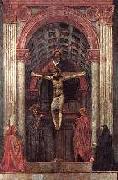 |
MASACCIO -- Click Here
|
|
Italian Early Renaissance Painter, 1401-1428
was the first great painter of the Quattrocento period of the Italian Renaissance. His frescoes are the earliest monuments of Humanism, and introduce a plasticity previously unseen in figure painting. The name Masaccio is a humorous version of Tommaso, meaning "big", "fat", "clumsy" or "messy" Tom. The name was created to distinguish him from his principal collaborator, also called Tommaso, who came to be known as Masolino ("little/delicate Tom"). Despite his brief career, he had a profound influence on other artists. He was one of the first to use scientific perspective in his painting, employing techniques such as vanishing point in art for the first time. He also moved away from the Gothic style and elaborate ornamentation of artists like Gentile da Fabriano to a more natural mode that employed perspective for greater realism. Masaccio was born to Giovanni di Mone Cassa??i and Jacopa di Martinozzo in Castel San Giovanni di Altura, now San Giovanni Valdarno (now part of the province of Arezzo, Tuscany). His father was a notary and his mother the daughter of an innkeeper of Barberino di Mugello, a town a few miles south of Florence. His family name, Cassai, comes from the trade of his grandfather Simone and granduncle Lorenzo, who were carpenters - cabinet makers ("casse", hence "cassai"). His father died in 1406, when Tommaso was only five; in that year another brother was born, called Giovanni after the dead father. He also was to become a painter, with the nickname of "Scheggia" meaning "splinter". The mother was remarried to an elderly apothecary, Tedesco, who guaranteed Masaccio and his family a comfortable childhood. |
|
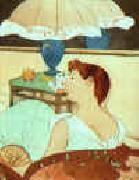 |
Mary Cassatt -- Click Here
|
|
1844-1926
Mary Cassatt Galleries
Within months of her return to Europe in the autumn of 1871, Cassatt??s prospects had brightened. Her painting Two Women Throwing Flowers During Carnival was well received in the Salon of 1872, and was purchased. She attracted much favorable notice in Parma and was supported and encouraged by the art community there: ??All Parma is talking of Miss Cassatt and her picture, and everyone is anxious to know her??.
After completing her commission for the archbishop, Cassatt traveled to Madrid and Seville, where she painted a group of paintings of Spanish subjects, including Spanish Dancer Wearing a Lace Mantilla (1873, in the National Museum of American Art, Smithsonian Institution). In 1874, she made the decision to take up residence in France. She was joined by her sister Lydia who shared an apartment with her. Cassatt continued to express criticism of the politics of the Salon and the conventional taste that prevailed there. She was blunt in her comments, as reported by Sartain, who wrote: ??she is entirely too slashing, snubs all modern art, disdains the Salon pictures of Cabanel, Bonnat, all the names we are used to revere??. Cassatt saw that works by female artists were often dismissed with contempt unless the artist had a friend or protector on the jury, and she would not flirt with jurors to curry favor. Her cynicism grew when one of the two pictures she submitted in 1875 was refused by the jury, only to be accepted the following year after she darkened the background. She had quarrels with Sartain, who thought Cassatt too outspoken and self-centered, and eventually they parted. Out of her distress and self-criticism, Cassatt decided that she needed to move away from genre paintings and onto more fashionable subjects, in order to attract portrait commissions from American socialites abroad, but that attempt bore little fruit at first.
In 1877, both her entries were rejected, and for the first time in seven years she had no works in the Salon. At this low point in her career she was invited by Edgar Degas to show her works with the Impressionists, a group that had begun their own series of independent exhibitions in 1874 with much attendant notoriety. The Impressionists (also known as the ??Independents?? or ??Intransigents??) had no formal manifesto and varied considerably in subject matter and technique. They tended to prefer open air painting and the application of vibrant color in separate strokes with little pre-mixing, which allows the eye to merge the results in an ??impressionistic?? manner. The Impressionists had been receiving the wrath of the critics for several years. Henry Bacon, a friend of the Cassatts, thought that the Impressionists were so radical that they were ??afflicted with some hitherto unknown disease of the eye??. They already had one female member, artist Berthe Morisot, who became Cassatt??s friend and colleague.
Degas, Portrait of Miss Cassatt, Seated, Holding Cards, c. 1876-1878, oil on canvasCassatt admired Degas, whose pastels had made a powerful impression on her when she encountered them in an art dealer's window in 1875. "I used to go and flatten my nose against that window and absorb all I could of his art," she later recalled. "It changed my life. I saw art then as I wanted to see it." She accepted Degas' invitation with enthusiasm, and began preparing paintings for the next Impressionist show, planned for 1878, which (after a postponement because of the World??s Fair) took place on April 10, 1879. She felt comfortable with the Impressionists and joined their cause enthusiastically, declaring: ??we are carrying on a despairing fight & need all our forces??. Unable to attend cafes with them without attracting unfavorable attention, she met with them privately and at exhibitions. She now hoped for commercial success selling paintings to the sophisticated Parisians who preferred the avant-garde. Her style had gained a new spontaneity during the intervening two years. Previously a studio-bound artist, she had adopted the practice of carrying a sketchbook with her while out-of-doors or at the theater, and recording the scenes she saw.
Summertime, c. 1894, oil on canvasIn 1877, Cassatt was joined in Paris by her father and mother, who returned with her sister Lydia. Mary valued their companionship, as neither she nor Lydia had married. Mary had decided early in life that marriage would be incompatible with her career. Lydia, who was frequently painted by her sister, suffered from recurrent bouts of illness, and her death in 1882 left Cassatt temporarily unable to work.
Cassatt??s father insisted that her studio and supplies be covered by her sales, which were still meager. Afraid of having to paint ??potboilers?? to make ends meet, Cassatt applied herself to produce some quality paintings for the next Impressionist exhibition. Three of her most accomplished works from 1878 were Portrait of the Artist (self-portrait), Little Girl in a Blue Armchair, and Reading Le Figaro (portrait of her mother).
Degas had considerable influence on Cassatt. She became extremely proficient in the use of pastels, eventually creating many of her most important works in this medium. Degas also introduced her to etching, of which he was a recognized master. The two worked side-by-side for awhile, and her draftsmanship gained considerable strength under his tutelage. He depicted her in a series of etchings recording their trips to the Louvre. She had strong feelings for him but learned not to expect too much from his fickle and temperamental nature. The sophisticated and well-dressed Degas, then forty-five, was a welcome dinner guest at the Cassatt residence.
The Impressionist exhibit of 1879 was the most successful to date, despite the absence of Renoir, Sisley, Manet and C??zanne, who were attempting once again to gain recognition at the Salon. Through the efforts of Gustave Caillebotte, who organized and underwrote the show, the group made a profit and sold many works, although the criticism continued as harsh as ever. The Revue des Deux Mondes wrote, ??M. Degas and Mlle. Cassatt are, nevertheless, the only artists who distinguish themselves??and who offer some attraction and some excuse in the pretentious show of window dressing and infantile daubing??.
Cassatt displayed eleven works, including La Loge. Although critics claimed that Cassatt??s colors were too bright and that her portraits were too accurate to be flattering to the subjects, her work was not savaged as was Monet's, whose circumstances were the most desperate of all the Impressionists at that time. She used her share of the profits to purchase a work by Degas and one by Monet. She exhibited in the Impressionist Exhibitions that followed in 1880 and 1881, and she remained an active member of the Impressionist circle until 1886. In 1886, Cassatt provided two paintings for the first Impressionist exhibition in the United States, organized by art dealer Paul Durand-Ruel. Her friend Louisine Elder married Harry Havemeyer in 1883, and with Cassatt as advisor, the couple began collecting the Impressionists on a grand scale. Much of their vast collection is now in the Metropolitan Museum of Art in New York City. She also made several portraits of family members during that period, of which Portrait of Alexander Cassatt and His Son Robert Kelso (1885) is one of her best regarded. Cassatt??s style then evolved, and she moved away from Impressionism to a simpler, more straightforward approach. She began to exhibit her works in New York galleries as well. After 1886, Cassatt no longer identified herself with any art movement and experimented with a variety of techniques.
|
|
 |
Mary Beale -- Click Here
|
|
English Baroque Era Painter, 1633-1699
was an English portrait painter. She became one of the most important portrait painters of 17th century England, and has been described as the first professional female English painter. Beale was born in Barrow, Suffolk, the daughter of John Cradock, a Puritan rector. Her mother, Dorothy, died when she was 10. She married Charles Beale, a cloth merchant from London, in 1652, at the age of 18. Her father and her husband were both amateur painters, her father being a member of the Painter-Stainers' Company, and she was acquainted with local local artists, such as Nathaniel Thach, Matthew Snelling, Robert Walker and Peter Lely. She became a semi-professional portrait painter in the 1650s and 1660s, working from her home, first in Covent Garden and later in Fleet Street. The family moved to a farmhouse in Allbrook, Hampshire in 1665 due to financial difficulties, her husband having lost his position as a clerk of patents, and also due to the Great Plague in London. For the next five years, a 17th-century two storey timber-framed building was her family home and studio. She returned to London in 1670, where she established a studio in Pall Mall, with her husband working as her assistant, mixing her paints and keeping her accounts. She became successful, and her circle of friends included Thomas Flatman, poet Samuel Woodford, Archbishop of Canterbury John Tillotson, and Bishops Edward Stillingfleet and Gilbert Burnet. She became reacquainted with Peter Lely, now Court Artist to Charles II. Her later work is heavily influenced by Lely, being mainly small portraits or copies of Lely's work. Her work became unfashionable after his death in 1680. |
|
 |
Marx Reichlich -- Click Here
|
|
1460-1520
German
Marx Reichlich Gallery
Austrian painter. His name, which first appeared in records of Salzburg citizens in 1494, has been linked (Semper) to an artist who signed some of his paintings with the initials M R. The earliest of the initialled panels, the Adoration of the Magi with the Donor Heinrich Mentlberger (1489; Innsbruck, ex-Wilten Abbey Church; Innsbruck, Tirol. Landesmus.), suggests that Reichlich had trained with the Tyrolean artists Friedrich Pacher and Michael Pacher. The latter lived in Salzburg from 1495 to 1498, and the stylistic association with him visible in the Perckhamer Altarpiece (c. 1495-8; Austria, priv. col., see Oberhammer, nos 1-12) may account for Reichlich's having become a citizen in Salzburg. The connections with both Pachers and the fact that Reichlich received several commissions in Neustift (Novacella, nr Bressanone) suggest that his origins were in that region. According to a receipt dated 1499, he painted a panel (untraced) for the Benediktinerstift of St Lambrecht in Styria. In 1508 Emperor Maximilian I commissioned him to restore the frescoes (in situ) in Schloss Runkelstein near Bozen (Bolzano). The latest panels signed with the initials M R make up part of a double-winged altarpiece (Heiligenblut, St Vincent) that was completed by one 'Wolffgang Maller' in 1520, perhaps because Reichlich was no longer living. Also attributed to Reichlich on stylistic, technical and circumstantial grounds are eight portraits (c. 1519-20) formerly assigned to a 'Master of the Angrer Portrait' whose name was derived from the riveting bust-length portrait of Canon Gregor Angrer of Brixen (1519; Innsbruck, Tirol. Landesmus.). |
|
1.jpg) |
MARTORELL, Bernat (Bernardo) -- Click Here
|
|
Spanish Early Renaissance Painter, ca.1400-1452 |
|
|
|
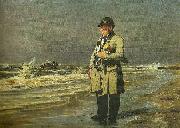 |
Martinus Rorbye -- Click Here
|
|
(17 May 1803 - 29 August 1848) was a Danish painter, known both for genre works and landscapes. He was a central figure of the Golden Age of Danish painting during the first half of the 19th century.
The most traveled of the Danish Golden Age painters, he traveled both north to Norway and Sweden and south to Italy, Greece and Constantinople. He was also the first Danish painter to take to painting in Skagen at the northern top of Jutland, almost half a century before the thriving community of Skagen Painters formed and came to fame.
Martinus Rørbye was born in Drammen in Norway to Danish parents Ferdinand Henrik Rørbye and his wife Frederikke Eleonore Catherine de Stockfleth. His father was a warehouse manager and later Superintendent of War, and had moved the family to Norway shortly before Martinus' birth. The family returned to Denmark when Martinus was 12 years old, shortly after the cession of Norway from Denmark in 1814.
Martinus was not inclined to schooling, but in 1820 started his studies at the Royal Danish Academy of Fine Arts at 17 years of age. He studied under Christian August Lorentzen and Christoffer Wilhelm Eckersberg, a strong influence on a generation of artists during the Danish Golden Age. Rørbye was a favorite student of Eckersberg, and they formed a close association. He took to Eckersberges careful attention to nature and his strivings to capture details realistically. He was also greatly influenced by Lorentzenes use of color.
He won the Academyes small silver medal in 1824, and the large silver medal in 1828. He competed for the gold medal and won a cash prize. In 1829 he won the small gold medal for his painting Christ healing the blind, which remains in the ownership of the Royal Danish Academy. He never won the large gold medal in spite of repeated attempts.
|
|
 |
Martin, John -- Click Here
|
|
English Romantic Painter, 1789-1854 |
|
 |
Martin van Meytens -- Click Here
|
|
(June 24, 1695 - March 23, 1770) was a Swedish-Austrian painter who painted members of the royal Court of Austria such as Marie Antoinette, Maria Theresa of Austria, Francis I, Holy Roman Emperor, the Emperor's family and others. His painting style has inspired many other painters to paint in a similar format.
|
|
 |
Martin Schongauer -- Click Here
|
|
1430-1491
German
Martin Schongauer Galleries
His father was a goldsmith named Casper, a native of Augsburg, who had settled at Colmar, where the chief part of Martin's life was spent. He may well have been trained by Master E. S.; A. Hyatt Mayor saw both their styles in different parts of one engraving, and all the works with Schongauer's M†S monogram show a fully developed style. Schongauer established at Colmar a very important school of engraving, out of which grew the "Little Masters" of the succeeding generation, and a large group of Nuremberg artists.
As a painter, Schongauer was a follower of the Flemish Rogier van der Weyden, and his rare existing pictures closely resemble, both in splendour of color and exquisite minuteness of execution, the best works of contemporary art in Flanders.
Porträt einer jungen Frau, by Martin Schongauer, c. 1478, located in Sammlung Heinz Kisters, Kreuzlingen (Schweiz) in GermanyAmong the very few paintings which can with certainty be attributed to him, the chief is a magnificent altar-piece in the church of Saint Martin at Colmar. The Mus??e d´Unterlinden in Colmar possesses eleven panels by him, and a small panel of David with Goliath's Head in the Munich Gallery is attributed to him. The miniature painting of the Death of the Virgin in the National Gallery, London is probably the work of some pupil. In 1488 Schongauer died at Colmar, according to the register of Saint Martin Church. Other authorities state that his death occurred in 1491.
The main work of Schongauer's life was the production of a large number of beautiful engravings, which were largely sold, not only in Germany, but also in Italy and even in England and Spain. Vasari says that Michelangelo copied one of his engravings, the Trial of Saint Anthony. His style shows no trace of Italian influence, but a very clear and organised Gothic.
His subjects are mainly religious, but include comic scenes of ordinary life such as the Peasant family going to market or the Two apprentices fighting. one hundred and sixteen engravings are generally recognised as by his hand, and since several are only known from a single impression, there were probably others that are now lost. Many of his pupils' plates as well as his own are signed, M†S, as are many copies probably by artists with no connection to him.
Crucifixion by Schongauer.Among the most renowned of Schongauer's engravings are the series of the Passion and the Death and Coronation of the Virgin, and the series of the Wise and Foolish Virgins. All are remarkable for their miniature-like treatment, their brilliant touch, and their chromatic force. Some, such as the Death of the Virgin and the Adoration of the Magi are richly-filled compositions of many figures, treated with much largeness of style in spite of their minute scale.
He established the system of depicting volume by means of cross-hatching (lines in two directions) which was further developed by D??rer, and was the first engraver to curve parallel lines, probably by rotating the plate against a steady burin. He also developed a burin technique producing deeper lines on the plate, which meant that more impressions could be taken before the plate became worn.
The British Museum and other major print rooms possess fine collections of Schongauer's prints. |
|
 |
Martin Mijtens d.a. -- Click Here
|
|
Martin Mijtens d.ä., Martin Meytens, Martin Mytens, född 1648 i Haag, Holland, död 1736 i Stockholm och begravd i Maria Kyrkan, nederländsk konstnär. Far till Martin Mijtens d.y. och son till porträttmålaren Isaac Mijtens.
Mijtens kom till Stockholm före eller under år 1677 och fann där ett så tacksamt fält för sin konst, att han beslöt stanna och 1681 satte han bo. Av hans första verk finns prov i Vibyholms och andra samlingar. De visar, att han hade en fin pensel, behaglig, varm, fastän tunn färg samt livlig och karakteristisk uppfattning av de skildrade. Med sina gråaktiga fonder, de ofta gulbruna draperierna och den enkla, naiva framställningen bildar Mijtens vid denna tid en bestämd motsats till David Klöcker Ehrenstrahl. Men dennes anseende och den gunst hans målningssätt vunnit var så stora, att även Mijtens måste böja sig. Så småningom blir hans bilder något anspråksfullare och djärvare, åtbörder och minspel kraftigare, bisakerna rikare, tonen i det hela mer högstämd, utan att personligheten försummas eller återgivningen av hudfärg överger den varma, åt gult dragande hållningen. Många bilder från denna hans andra period, som ungefär omfattar åren 1685- 1700, finns på Skoklosters slott, där Nils Bielke och hans grevinna, Eva Horn (i landskap), hör till mästarens bästa målningar, och på Vibyholm, i Uppsala (professor Schwedes porträtt i Uppsala museum och Olof Rudbeck d.ä.:s förträffliga bild, 1696, i medicinska fakultetens sessionsrum), i Hammers samling och på inte så få andra ställen. Konstnärens vana att högst sällan signera har gjort, att bilderna från dessa år ofta har blandats ihop med Ehrenstrahls och gått under den senares namn. Säkra skiljetecken är emellertid draperierna, som hos Mijtens saknar stil och ofta verkar tämligen slappt tecknade, och även det livligare åtbördsspelet. Man vet, att Mijtens, trots sin medtävlares anseende, var mycket eftersökt som porträttmålare och samlade förmögenhet på sin konst, så att han kunde bl.a. förvärva ett ej obetydligt konstgalleri. Han var även alltifrån 1692 och ganska länge kyrkoråd i den lilla holländska församlingen i Stockholm. 1697 och 1701 företog han resor till hembygden, den förra gången åtföljd av sin unge lärjunge Lucas von Breda. Utom denne ej obetydande konstnär utbildade Mijtens även sin son , som under det i Tyskland antagna namnet van Meytens berömde målaren (se denne), samt G. de Mar??es och möjligen flera. Man kan säga att omkring år 1700 vidtog Mijtens tredje maner. Karnationen får en dragning åt rött, som slutligen blir nästan stötande (t. ex. i Fabritius och prins Alexander av Georgiens porträtt på Gripsholms slott), teckningen vårdslösas mer, och de granna röda eller djupblå draperierna är stillösare och hårdare målade än förr. Dock lever ännu inte litet av den forna kraften i karaktärsteckningen, och anordningen bibehåller i mycket den förra prydligheten. Även denna hans nedgång finnes ej sällan företrädd i svenska samlingar. Märkligt är ett självporträtt (nu på Fånö i Uppland), emedan det enligt sägnen skall vara målat på hans höga ålderdom och under sinnessvaghet (om denna vet man för övrigt inget). Utom måleriet idkade han även gravyr samt utförde ett porträtt af Karl XI i svart maner och möjligen ett par andra blad i samma art (Gustaf Adolf de la Gardie, Georg Stiernhielm). Mijtens skall, enligt gammal uppgift, ha avlidit i Stockholm 1736; enligt en urkund levde han ännu i juli 1730. Hans målningssamling såldes av hans arvingar till preussiske överstemarskalken greve Gotter och kom inte långt därefter till storhertigen af W??rttemberg. Carl Gustaf Tessin, som tycks ha hyst mycken ringaktning för Mijtens omtalar dock, att denna samling på sin tid ansågs som den enda framstående i riket (utom grefve Johan Gabriel Stenbocks). Att Carl Gustaf Tessin vid samma tillfälle kallar Mijtens "en gammal färgskämmare" och även annars talar illa om hans konst, tycks visa att Mijtens vid mitten af 1700-talet var fullkomligt bortglömd, åtminstone sådan han varit under sin bästa tid. Sedan finns han ej heller mycket omtalad. Först genom konstföreningens utställning 1841 och Nils Arfwidssons anmälan av honom i Frey återupptäcktes han; och man fann då, att Sverige i honom ägt en konstnär av sådan betydelse, att han kan mäta sig även med våra största mästare. Hans inflytande på den svenska konstens fortbildning blev dock ej särskilt stort. David Klöcker Ehrenstrahl och David von Krafft ställer honom i det avseendet fullkomligt i skuggan.
|
|
 |
martin mijtens d.a -- Click Here
|
|
Martin Mijtens d.ä., Martin Meytens, Martin Mytens, född 1648 i Haag, Holland, död 1736 i Stockholm och begravd i Maria Kyrkan, nederländsk konstnär. Far till Martin Mijtens d.y. och son till porträttmålaren Isaac Mijtens.
Mijtens kom till Stockholm före eller under år 1677 och fann där ett så tacksamt fält för sin konst, att han beslöt stanna och 1681 satte han bo. Av hans första verk finns prov i Vibyholms och andra samlingar. De visar, att han hade en fin pensel, behaglig, varm, fastän tunn färg samt livlig och karakteristisk uppfattning av de skildrade. Med sina gråaktiga fonder, de ofta gulbruna draperierna och den enkla, naiva framställningen bildar Mijtens vid denna tid en bestämd motsats till David Klöcker Ehrenstrahl. Men dennes anseende och den gunst hans målningssätt vunnit var så stora, att även Mijtens måste böja sig. Så småningom blir hans bilder något anspråksfullare och djärvare, åtbörder och minspel kraftigare, bisakerna rikare, tonen i det hela mer högstämd, utan att personligheten försummas eller återgivningen av hudfärg överger den varma, åt gult dragande hållningen. Många bilder från denna hans andra period, som ungefär omfattar åren 1685- 1700, finns på Skoklosters slott, där Nils Bielke och hans grevinna, Eva Horn (i landskap), hör till mästarens bästa målningar, och på Vibyholm, i Uppsala (professor Schwedes porträtt i Uppsala museum och Olof Rudbeck d.ä.:s förträffliga bild, 1696, i medicinska fakultetens sessionsrum), i Hammers samling och på inte så få andra ställen. Konstnärens vana att högst sällan signera har gjort, att bilderna från dessa år ofta har blandats ihop med Ehrenstrahls och gått under den senares namn. Säkra skiljetecken är emellertid draperierna, som hos Mijtens saknar stil och ofta verkar tämligen slappt tecknade, och även det livligare åtbördsspelet. Man vet, att Mijtens, trots sin medtävlares anseende, var mycket eftersökt som porträttmålare och samlade förmögenhet på sin konst, så att han kunde bl.a. förvärva ett ej obetydligt konstgalleri. Han var även alltifrån 1692 och ganska länge kyrkoråd i den lilla holländska församlingen i Stockholm. 1697 och 1701 företog han resor till hembygden, den förra gången åtföljd av sin unge lärjunge Lucas von Breda. Utom denne ej obetydande konstnär utbildade Mijtens även sin son , som under det i Tyskland antagna namnet van Meytens berömde målaren (se denne), samt G. de Marees och möjligen flera. Man kan säga att omkring år 1700 vidtog Mijtens tredje maner. Karnationen får en dragning åt rött, som slutligen blir nästan stötande (t. ex. i Fabritius och prins Alexander av Georgiens porträtt på Gripsholms slott), teckningen vårdslösas mer, och de granna röda eller djupblå draperierna är stillösare och hårdare målade än förr. Dock lever ännu inte litet av den forna kraften i karaktärsteckningen, och anordningen bibehåller i mycket den förra prydligheten. Även denna hans nedgång finnes ej sällan företrädd i svenska samlingar. Märkligt är ett självporträtt (nu på Fånö i Uppland), emedan det enligt sägnen skall vara målat på hans höga ålderdom och under sinnessvaghet (om denna vet man för övrigt inget). Utom måleriet idkade han även gravyr samt utförde ett porträtt af Karl XI i svart maner och möjligen ett par andra blad i samma art (Gustaf Adolf de la Gardie, Georg Stiernhielm). Mijtens skall, enligt gammal uppgift, ha avlidit i Stockholm 1736; enligt en urkund levde han ännu i juli 1730. Hans målningssamling såldes av hans arvingar till preussiske överstemarskalken greve Gotter och kom inte långt därefter till storhertigen af Werttemberg. Carl Gustaf Tessin, som tycks ha hyst mycken ringaktning för Mijtens omtalar dock, att denna samling på sin tid ansågs som den enda framstående i riket (utom grefve Johan Gabriel Stenbocks). Att Carl Gustaf Tessin vid samma tillfälle kallar Mijtens "en gammal färgskämmare" och även annars talar illa om hans konst, tycks visa att Mijtens vid mitten af 1700-talet var fullkomligt bortglömd, åtminstone sådan han varit under sin bästa tid. Sedan finns han ej heller mycket omtalad. Först genom konstföreningens utställning 1841 och Nils Arfwidssons anmälan av honom i Frey återupptäcktes han; och man fann då, att Sverige i honom ägt en konstnär av sådan betydelse, att han kan mäta sig även med våra största mästare. Hans inflytande på den svenska konstens fortbildning blev dock ej särskilt stort. David Klöcker Ehrenstrahl och David von Krafft ställer honom i det avseendet fullkomligt i skuggan. |
|
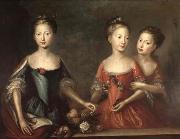 |
Martin Maingaud -- Click Here
|
|
Martin Maingaud (died 1725; fl.1692-c.1725) was a French portraitist.
|
|
 |
martin luther -- Click Here
|
|
Born: 10 November 1483
Birthplace: Eisleben, Germany
Died: 18 February 1546
Best Known As: German monk who started Protestant Reformation |
|
 |
Martin Johnson Heade -- Click Here
|
|
American Hudson River School Painter, 1819-1904 Martin Johnson Heade (August 11, 1819-September 4, 1904) was a prolific American painter known for his salt marsh landscapes, seascapes, portraits of tropical birds, and still lifes. His painting style and subject matter, while derived from the romanticism of the time, is regarded by art historians as a significant departure from that of his peers.
Art historians have come to disagree with the common view that Heade is a Hudson River School painter, a view given wide currency by Heade's inclusion in a landmark exhibition of Hudson River School landscapes at the Metropolitan Museum of Art in 1987.
The leading Heade scholar and author of Heade's catalogue raisonn??, Theodore E. Stebbins, Jr., wrote some years after the 1987 Hudson River School exhibition that "...other scholars??myself included??have increasingly come to doubt that Heade is most usefully seen as standing within that school."
According to the Heade catalogue raisonn??, only around 40 percent of his paintings were landscapes. The remaining majority were still lifes, paintings of birds, and portraits, subjects unrelated to the Hudson River School. Of Heade's landscapes, perhaps only 25 percent were painted of traditional Hudson River School subject matter.
Heade had less interest in topographically accurate views than the Hudson River painters, and instead focused on mood and the effects of light. Stebbins writes, "If the paintings of the shore as well as the more conventional compositions...might lead one to think of Heade as a Hudson River School painter, the [marsh scenes] make it clear that he was not." |
|
 |
Martin Johann Schmidt -- Click Here
|
|
Austrian Painter, 1718-1801,was one of the most outstanding Austrian painters of the late Baroque/Rococo along with Franz Anton Maulbertsch. A son of the sculptor Johannes Schmidt and a pupil of Gottlieb Starmayr, he spent most of his life at Stein, where he mostly worked in the numerous churches and monasteries of his Lower Austrian homeland. While the evolution of his style after 1750 shows that he had either spent a formative period in northern Italy or had at least had extensive contact with northern Italian works of art prior to that date, his works are also clearly influenced by Rembrandt (visible above all in his etchings) and the great fresco-painters of the Austrian Baroque, Paul Troger and Daniel Gran. Despite not having received formal academic training, in 1768 he was made a member of the imperial academy at Vienna due to his artistic merits, which by that time had already been recognized by a wider public inside and outside of Austria. Primarily he painted devotional images for private devotion and churches, including a considerable number of large altar paintings. His lively and colourful style made him extremely popular with people from all levels of society already during his lifetime. From 1780 mythological and low-life themes became increasingly frequent, only to be replaced by a renewed concentration on religious topics during the very last years of Schmidt's life. He was at that an important draughtsman and has left numerous etchings which clearly show Rembrandt's influence. While his earlier works typically show a warm chiaroscuro, from about 1770 he used increasingly stronger and more lively colours. Simultanueously, both his style and his brush technique became much more free, making him, like Franz Anton Maulbertsch, an important predecessor of impressionism. In this aspect, his mature style is completely contrary to neoclassicism, the style which increasingly dominated European art after about 1780. |
|
 |
Martin Drolling -- Click Here
|
|
French Academic Painter, 1752-1817,After receiving initial training from an unknown painter in Selestat, Drolling moved to Paris, where he attended courses at the Acad?mie Royale. He supplemented his education there by studying Flemish and Dutch Old Masters in the collection at the Luxembourg Palace. From the Flemish school he derived his own rich impasto, while the Dutch was to influence him in his meticulous, supremely descriptive and unsentimental style of painting as well as his choice of subject-matter: unfussy bourgeois interiors and frank portraits. Drolling first exhibited at the Salon de la Correspondance in 1781 and again in 1782 and 1789. After the French Revolution he was able to participate in the Salon at the Louvre, despite the fact that he had never become a member of the Academie Royale. He exhibited from 1793 to 1817, although the majority of his works extant today were shown after 1800. From 1802 to 1813 he was employed by the Sevres porcelain manufactory, and many of his designs were engraved. |
|
 |
Martin Archer Shee -- Click Here
|
|
RA (December 23, 1769 - August 13, 1850) was a British portrait painter and president of the Royal Academy.
He was born in Dublin, of an old Catholic Irish family, and his father, a merchant, regarded the profession of a painter as an unsuitable occupation for a descendant of the Shees. Martin Shee nevertheless studied art in the Dublin Society, and came to London. There, in 1788, he was introduced by William Burke to Joshua Reynolds, on whose advice he studied in the schools of the Royal Academy. In 1789 he exhibited his first two pictures, the "Head of an Old Man" and "Portrait of a Gentleman." Over the next ten years he steadily increased in practice. He was chosen an associate of the Royal Academy in 1798, in 1789 he married, and in 1800 he was elected a Royal Academician. He moved to George Romney's former house in Cavendish Square, and set up as his successor.
Shee continued to paint with great readiness of hand and fertility of invention, although his portraits were eclipsed by more than one of his contemporaries, and especially by Thomas Lawrence. The earlier portraits of the artist are carefully finished, easy in action, with good drawing and excellent discrimination of character. They show an undue tendency to redness in the flesh painting defect which is still more apparent in his later works, in which the handling is less "square," crisp and forcible. In addition to his portraits he executed various subjects and historical works, such as Lavinia, Belisarius, his diploma picture "Prospero and Miranda", and the "Daughter of Jephthah."
In 1805 he published a poem consisting of Rhymes on Art, and a second part followed in 1809. Lord Byron spoke well of it in his English Bards and Scotch Reviewers. Shee published another small volume of verse in 1814, entitled The Commemoration of Sir Joshua Reynolds, and other Poems, but this was less successful. He also produced a tragedy, Alasco, set in Poland. The play was accepted at Covent Garden, but was refused a licence, on the grounds that it contained treasonable allusions, and Shee angrily resolved to make his appeal to the public. He carried out his threat in 1824, but Alasco was still on the list of unacted dramas in 1911. He also published two novels - "Oldcourt" (1829, in 3 volumes) and "Cecil Hyde" (1834). |
|
 |
Martin Drolling -- Click Here
|
|
1752-1817
B.Oberbergheim
French Martin Drolling Art Gallery
After receiving initial training from an unknown painter in Selestat, Drolling moved to Paris, where he attended courses at the Academie Royale. He supplemented his education there by studying Flemish and Dutch Old Masters in the collection at the Luxembourg Palace. From the Flemish school he derived his own rich impasto, while the Dutch was to influence him in his meticulous, supremely descriptive and unsentimental style of painting as well as his choice of subject-matter: unfussy bourgeois interiors and frank portraits. Drolling first exhibited at the Salon de la Correspondance in 1781 and again in 1782 and 1789. After the French Revolution he was able to participate in the Salon at the Louvre, despite the fact that he had never become a member of the Academie Royale. He exhibited from 1793 to 1817, although the majority of his works extant today were shown after 1800. From 1802 to 1813 he was employed by the Sevres porcelain manufactory, and many of his designs were engraved. |
|
 |
Marten van Cleve -- Click Here
|
|
Flemish, 1527-1581,Brother of Hendrik van Cleve III. His presumed date of birth is derived from a document of 2 April 1567 in which he declared his age to be 40. In 1551-2 he became a master in the Antwerp Guild of St Luke and, according to van Mander, followed his brother into the studio of Frans Floris. If this is correct, it was probably c. 1553-5, for motifs drawn from Floris's work appear in Marten van Cleve's paintings executed during these years. Marten married Maria de Greve on 7 January 1556, apparently setting up his own studio at about the same time. Apprentices are regularly recorded from 1558 onwards, and it is probable that his own sons, Gillis II, Marten the younger, Joris and Nicolaas, also worked in the studio. Throughout the 1560s and 1570s Marten van Cleve's workshop was very productive, but the majority of works painted consisted of copies of his own originals. Van Mander's statement that the artist collaborated with a number of landscape painters, including his brother Hendrik III, Gillis van Coninxloo III, Gillis Mostaert and Jacob Grimmer, is confirmed by 17th-century inventories. |
|
 |
Marten Rijckaert -- Click Here
|
|
Belgium (1587-1631 ) - Painter |
|
 |
Marten Pepijn -- Click Here
|
|
Belgium (1575-1643 ) - Painter
Date of Birth: 1575
Date of Death: 1643 |
|
 |
Marten de Vos -- Click Here
|
|
(1532-1603), also Maarten, was a leading Antwerp painter and draughtsman in the late sixteenth century.
|
|
 |
Marstrand, Wilhelm -- Click Here
|
|
Danish, 1810-1873
Danish painter and illustrator. He was a student of C. W. Eckersberg at the Kunstakademi in Copenhagen (1825-33). His art reflects his constant observation of the world around him, in particular middle-class society, and the narrative element dominated his pictures of crowds in the city streets. Throughout his life he sought inspiration from literature and the theatre. In his early genre painting Moving Day Scene (1831; Niv?, Nivaagaards Malsaml.) it was the popular novelty of vaudeville that interested him. The October Festival (1839; Copenhagen, Thorvaldsens Mus.) reveals how Marstrand's five-year stay (1836-41) in Italy opened his eyes to the classical ideal of beauty. It was, however, an ideal that found little response in contemporary Denmark, and he turned towards a more anecdotal and humorous approach. In Scene of Country Life (1843; Copenhagen, Kon. Dan. Kstakad.), painted as a set subject for the Kunstakademi, Marstrand took as his theme a scene from Erasmus Montanus, a play by the 18th-century Danish poet and playwright Ludvig Holberg. Thereafter Holberg's comedies provided an inexhaustible source that satisfied Marstrand's need to pursue his investigations of human character. Family life similarly interested him throughout his career, as in his Scene of Daily Life (1857; Copenhagen, Stat. Mus. Kst). Such group portraits as The Waagepetersen Family (1836; Copenhagen, Stat. Mus. Kst) show an equal concern to depict the quiet details of Danish domestic life. Marstrand continued to travel abroad in search of inspiration. His stay in Venice in 1853-4 was particularly important; his studies there of the great Venetian painters improved his understanding of the handling of colour, as seen clearly in the many historical and religious paintings of his last years. Of particular interest is his mural decoration of Christian IV's chapel in Roskilde Cathedral (1864-6) with scenes from the life of the Danish monarch. Marstrand's paintings have a certain facetiousness which often obscures a much deeper philosophical content. For this reason, it is his drawings that arouse more admiration. |
|
 |
Marshall, Thomas Falcon -- Click Here
|
|
English, 1818-1878 |
|
 |
Marsal, Mariano Fortuny y -- Click Here
|
|
Spanish, 1838-1874
Painter and etcher. His work drew both on earlier Spanish art, especially the paintings and etchings of Goya, and on contemporary foreign works, notably the paintings of the Italian Macchiaioli and those of the French artist Ernest Meissonier. |
|
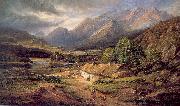 |
Marquis, James Richard -- Click Here
|
|
Irish, Scottish heritage, Active 1835-85 |
|
 |
Marques, Francisco Domingo -- Click Here
|
|
Spanish, 1842-1920 |
|
 |
Maroniez Georges-Philibert -- Click Here
|
|
French genre, seascape, and landscape Painter , 1865-Douai,1933
|
|
 |
Maron, Anton von -- Click Here
|
|
Austrian, 1733-1808
Austrian painter. He studied at the Vienna Akademie and, in 1755, he went to Rome, where he was based for the rest of his life. From 1756 to 1761 he was first the pupil then the assistant of Anton Raphael Mengs. In 1765 he married Mengs's sister, the miniature painter Theresia Concordia Mengs. After collaborating on Mengs's fresco paintings in Rome (at S Eusebio and the Villa Albani; both in situ), Maron, working independently in Rome, spent some time on altar pictures (S Maria dell'Anima) and on various decorative projects. Mengs's influence is evident in Maron's ceiling pictures in the casino of the Villa Borghese (1784; in situ), where five paintings tell the Story of Aeneas and Dido in the style of quadri riportati, using clear construction, sharply defined drawing and a historical concept based on antiquity. Although he received many commissions for this type of work, Maron's true gifts lay in the field of portraiture. Along with Pompeo Batoni, Maron was the most celebrated portrait painter in 18th-century Rome, and he received an enormous number of commissions from princes, diplomats and church dignitaries and from English aristocrats visiting Rome as part of their Grand Tour. Maron painted such sitters in the same style as did Batoni, usually full-length and life-size, in elegantly fashionable dress, against backgrounds of Classical sculptures and views of Rome. Portraits such as those of Francis, Prince of Anhalt Dessau |
|
 |
Marmion, Simon -- Click Here
|
|
French-born Flemish Northern Renaissance Painter, ca.1425-1489
French illuminator and painter. He was trained in Amiens and established a productive workshop in Valenciennes, but at the end of his career appears to have had connections with manuscript painting in the southern Netherlands. Although no signed or documented works survive, many illuminated manuscripts and some panel paintings have been convincingly attributed to him and his workshop. On the basis of these he has been recognized as an important figure in the development of both French and Netherlandish painting. |
|
|
|
 |
Marlow, William -- Click Here
|
|
English, 1740-1813
English painter. From c. 1756 to 1761 he was a pupil of Samuel Scott, the topographical and marine painter; he also studied at the St Martin's Lane Academy, London. Throughout his career Marlow made oils and watercolours of London views, for example Near Westminster Bridge, Evening (London, Guildhall A.G.), which shows his balanced, classical sense of composition, sensitivity to lighting effects and smooth handling of oil paint. Between 1765 and 1766 Marlow travelled in France and Italy, making numerous drawings of ruins, which provided the subjects for many paintings finished on his return to London. An Oxcart in the Grotto of Posillipo (c. 1770; New Haven, CT, Yale Cent. Brit. A.) exemplifies his bold, blue-toned watercolour style, with washes applied in loose blotches to emphasize the picturesque roughness of masonry and terrain. The handling has much in common with Canaletto, whom Marlow copied; a letter of 1771 from Horace Walpole to Sir Horace Mann (see 1956 exh. cat., p. 3) records that two views of Verona by Marlow were mistakenly sold as Canalettos. Marlow specialized in souvenirs of the Grand Tour, portraits of country houses, seascapes and river scenes. He visited many parts of Britain and Ireland in search of subjects, such as Powys Castle, Montgomeryshire (U. Manchester, Whitworth A.G.). |
|
 |
Markus Pernhart -- Click Here
|
|
Markus Pernhart (1824-1871) |
|
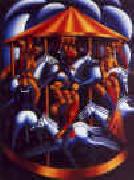 |
Mark Gertler -- Click Here
|
|
British
1891-1939
Mark Gertler Gallery
English painter. He was the son of Polish Jews and was brought up in Whitechapel in severe poverty until his father furrier workshop became moderately successful. As a child he knew nothing of art except advertisements and the work of pavement artists. He was 14 before he heard of any art institutions, and his career was determined by the discovery of W. P. Frith Autobiography in a secondhand bookshop. In 1906 he began attending art classes at the Regent Street Polytechnic in London, as well as a series of talks on Dutch and Flemish painting. His earliest still-lifes show the influence of Dutch 17th-century painting and the work of Chardin. Gertler left the Polytechnic for financial reasons in 1907 and apprenticed himself to Clayton and Bell, a firm of glass painters. In 1908 he won a prize in a national art competition and, on the strength of this, successfully applied for financial assistance from the Jewish Educational Aid Society, using William Rothenstein as a referee. That autumn he entered the Slade School of Fine Art, where he was taught by Henry Tonks and Philip Wilson Steer. He won several prizes and scholarships and fell in love with Dora Carrington. This and other friendships established at the Slade introduced him into a society that gave him a new perspective on his own family background. While writing delightedly to others of his nice friends among the upper classes, his paintings |
|
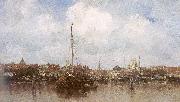 |
Maris, Jacob -- Click Here
|
|
Dutch, 1837-1899
was a Dutch painter, who with his brothers Willem and Matthijs belonged to what has come to be known as the Hague School of painters. Maris studied at the Antwerp Academy, and subsequently in Hubertus van Hove's studio during a stay in Paris from 1865 till 1871. He returned to Holland when the Franco-Prussian War broke out, and died there in August 1899. Though he painted, especially in early life, domestic scenes and interiors invested with deeply sympathetic feeling, it is as a landscape painter that Maris excelled. He was the painter of bridges and windmills, of old quays, massive towers, and level banks; even more was he the painter of water, and misty skies, and chasing clouds. In all his works, whether in water or oil color, and in his etchings, the subject is always subordinate to the effect. His art is suggestive rather than decorative, and his force does not seem to depend on any preconceived method, such as a synthetical treatment of form or gradations of tone. And yet, though his means appear so simple, the artist's mind seems to communicate with the spectator's by directness of pictorial instinct, and we have only to observe the admirable balance of composition and truthful perspective to understand the sure knowledge of his business that underlies such purely impressionist handling. Maris has shown all that is gravest or brightest in the landscape of Holland, all that is heaviest or clearest in its atmosphere for instance, in the " Grey Tower, Old Amsterdam," in the " Landscape near Dordrecht," in the " Sea-weed Carts, Scheven-ingen," in " A Village Scene," and in the numerous other pictures which have been exhibited in the Royal Academy, London, in Edinburgh (1885), Paris, Brussels |
|
 |
Mariotto Di Cristofano -- Click Here
|
|
San Giovanni Valdarno, 1393 - Firenze, 1457 |
|
 |
Mariotto Albertinelli -- Click Here
|
|
(October 13, 1474 - November 5, 1515) was a High Renaissance Italian painter of the Florentine school, closely involved with Fra Bartolomeo and influenced by Raphael.
He was born in Florence.
Already as a 12-year old boy, he became a pupil of Cosimo Rosselli, and a fellow-pupil with Fra Bartolomeo with whom he formed such an intimate brotherly rapport that in 1494 the two started their own studio in Florence. Vasari's opinion was that Mariotto was not so well grounded in drawing as Bartolomeo, and he tells that, to improve his hand he had taken to drawing the antiquities in the Medici garden, where he was encouraged by Madonna Alfonsina, the mother of Duke Lorenzo II de' Medici. When the Medici were temporarily banished in 1494, he returned to his friend, whose manner he copied so assiduously, according to Vasari, that his works were taken for Baccio's. When, in the wake of Savonarola's morality campaign, Baccio joined the Dominican order as Fra Bartolomeo in 1500 and gave up painting, Albertinelli, beside himself with the loss, would have joined him; but, spurred by his success in completing an unfinished Last Judgment of Bartolomeo's, he resolved to carry on alone. Among his many students were Jacopo da Pontormo, Innocenzo di Pietro Francucci da Imola and Giuliano Bugiardini.
Mariotto was a most restless person and carnal in the affairs of love and apt to the art of living, and, taking a dislike to the studies and brain-wracking necessary to painting, being also often stung by the tongues of other painters, as is their way, he resolved to give himself to a less laborious and more jovial profession, and so opened the most lovely hostelry outside the Porta San Gallo, and at the sign of the Dragon at the Ponte Vecchio a tavern and inn. This life he led for many months, saying that he had taken up an art that was without muscles, foreshortening or perspective and, better still, without faultfinding, and that the art that he had given up imitated flesh and blood, but this one created flesh and blood; in this if you had good wine you heard yourself praised, but in that every day you were blamed. But at last the low life became an annoyance to him, and, filled with remorse, he returned to painting. |
|
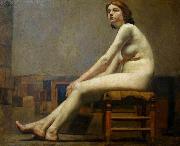 |
Mario Villares Barbosa -- Click Here
|
|
painted Nu feminino in 1880 - 1917 |
|
 |
Mario Dei Fiori -- Click Here
|
|
Italian painter , Penna Fermana 1603- Rome 1673
Italian painter. He was the first and most famous Roman painter to specialize in flower-pieces and one of only four still-life artists included by Leone Pascoli in his collection of artists' biographies. The early sources and old inventories attribute many flower paintings in distinguished Roman collections to the Caravaggesque painter Tommaso Salini, and since the 18th century Mario's name has been linked with his, and it has been assumed that he trained with Salini. This apprenticeship is difficult to document, yet a comparison of Mario's pictures with inventory descriptions of works by Salini confirms that Mario was influenced by his art. To the minute observation of various kinds of flowers, Mario added a refined sense of design and an interest in effects of light, still linked to Caravaggio in the use of a dark background. |
|
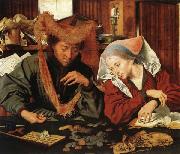 |
Marinus van Reymerswaele -- Click Here
|
|
Flemish Northern Renaissance Painter, ca.1490-1567
South Netherlandish painter. He has been identified with Marino di Sirissea and with Marinus de Seeu, painter of Romerswaelen, mentioned respectively by Guicciardini and van Mander. He could quite possibly have been Moryn Claessone, native of Zeeland, who enrolled as a pupil of 'Simon the glassmaker' in the Antwerp Guild of St Luke in 1509. In that case he would have been born c. 1490-95. Claes van Ziericsee, an artist who became master of the Guild in 1475, is assumed to have been his father though this cannot be proved conclusively. Van Reymerswaele's work corresponds closely with Antwerp painting of the beginning of the 16th century |
|
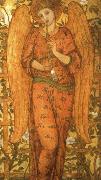 |
marin mersenne -- Click Here
|
|
French mathematician,philosopher and theorist. One of the leading French thinkers of the 17th century, he lived in Paris from 1619 as a Jesuit priest. His work is central to the academic and scientific movements of his time, and a major part of it is devoted to music. On the basis of practical experiment and observations, he made important discoveries concerning the nature and behaviour of sound, which are the foundation of the science of acoustics in later times. He also wrote on the theory and practice of music. His principal musical treatise is the Harmonie universelle |
|
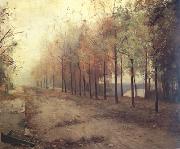 |
Mariia Konstantinovna Bashkirtseva -- Click Here
|
|
impression artist
F: J 1858 Nov 12 (wrongly 1860
Nov 23) - 1884 Oct 31 |
|
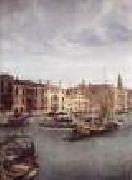 |
MARIESCHI, Michele -- Click Here
|
|
Italian Painter, 1710-1743
Italian painter and engraver. His first biographers, Orlandi and Guarienti (1753), stated that Marieschi worked in Germany early in his career and then returned to Venice, where he established himself as a painter of 'beautiful views of the Grand Canal, and of churches and palaces'. Yet there is no other evidence for this journey and Marieschi's early training remains problematic. It seems likely that he began his career as a stage designer: his first recorded activity, in 1731, was the preparation, on behalf of the impresario Francesco Tasso ( fl 1725-c. 1740), of the setting for the Venetian celebration of Carnival Thursday in the Piazzetta. He then, influenced by Marco Ricci and Luca Carlevaris, began to paint capriccios and vedute. His early capriccios, such as the pair Capriccio with Classical Ruins and Bridge and Capriccio with Roman Arch and Encampment (mid-1730s; Naples, Mus. Civ. Gaetano Filangieri), are indebted to Ricci, although they lack his solemnity and magnificence. Marieschi's blend of medieval and Classical ruins in a serene Venetian landscape is more picturesque and romantic. Marieschi began to paint vedute having been encouraged by Canaletto's great success with the genre; examples such as the S Maria della Salute (1733-5; Paris, Louvre), the Piazzetta dei Leoni and the Grand Canal at Ca' Pesaro (1734-5; both Munich, Alte Pin.) are distinguished from Canaletto's work by their exaggerated perspective, more atmospheric colour and the spirited handling of the small figures. Two capriccios, the Town on a River with Rapids (London, N.G.) and the Town on a River with Shipping (London, N.G.;.), both charmingly picturesque scenes with watermills and crumbling towers, date from the mid-1730s. Marieschi began to etch in the 1730s, |
|
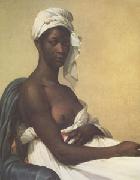 |
Marie-Guillemine Benoist -- Click Here
|
|
Paris 1768-1826
was a French neoclassical, historical and genre painter. She was born in Paris, the daughter of a civil servant. Her training as an artist began in 1781 under Élisabeth Vigee Le Brun, and she entered Jacques-Louis David's atelier in 1786 along with her sister Marie-Élisabeth Laville-Leroux. The poet Charles-Albert Demoustier, who met her in 1784, was inspired by her in creating the character Émile in his work Lettres Émilie sur la mythologie (1801). In 1791 she exhibited for the first time in the Salon de Paris, displaying her mythology-inspired picture Psych faisant ses adieux sa famille. Another of her paintings of this period, L'Innocence entre la vertu et le vice, is similarly mythological and reveals her feminist interests in this picture, vice is represented by a man, although it was traditionally represented by a woman. In 1793, she married the lawyer Pierre-Vincent Benoist. Her work, reflecting the influence of Jacques-Louis David, tended increasingly toward history painting by 1795. In 1800, she exhibited Portrait d'une negresse in the Salon. Six years previously, slavery had been abolished, and this image became a symbol for women's emancipation and black people's rights. This picture was acquired by Louis XVIII for France in 1818. An important commission, for a full-length portrait of Napol on Bonaparte Premier Consul Français in this period was awarded to her in 1803. This portrait was to be sent to the city of Ghent, newly ceded to France by the Treaty of Luneville in 1801. Other honors came to her; she was awarded a Gold Medal in the Salon of 1804, and received a governmental allowance. During this time she opened an atelier for the artistic training of women. Her career was harmed by political developments, however, when her husband, the convinced royalist count Benoist, was nominated in the Conseil d'État during the post-1814 monarchy come-back called the Bourbon Restoration. |
|
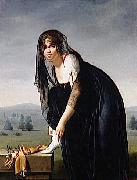 |
Marie-Denise Villers -- Click Here
|
|
(1774 - August 19, 1821) was a French painter, who specialized in portraits. She was born Marie-Denise Lemoine in Paris. She came from an artistic family, and her sisters Marie-Victoire Lemoine and Marie-Élisabeth Gabiou were also accomplished artists. In 1794, Marie-Denise married an architecture student, Michel-Jean-Maximilien Villers.
Villers was a student of the French painter Anne-Louis Girodet de Roussy-Trioson. She was first exhibited at the Paris Salon of the Year VII (1799). Villers' most famous painting, Young Woman Drawing, |
|
 |
Marie Wiegmann -- Click Here
|
|
painted Mrs. Carl vom Rath in 1866 |
|
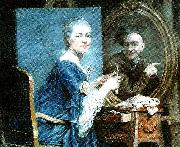 |
marie suzanne giroust roslin -- Click Here
|
|
Marie-Suzanne Giroust, född 9 mars 1734 i Paris, Frankrike, död 31 augusti 1772 i Paris, var en fransk konstnär, i huvudsak verksam inom pastellmåleri. Hon var gift med den svenske porträttmålaren Alexander Roslin från 1759 till sin död.
Dotter till Barthelemy Giroust och Marie Suzanne Leroy. När Giroust var sju år gammal, dog hennes far som var juvelerare. Fyra år senare dog även hennes mor, och hon flyttade in hos släktingar. Arvet efter fadern gav henne möjlighet att uppta målarstudier. Hon inledde sina studier hos Maurice Quentin de La Tour, men det var hos Joseph-Marie Vien hon kom att finna sig tillrätta. I Viens atelj?? träffade hon 1752 Alexander Roslin och blev förälskad. Girousts förmyndare kunde dock inte acceptera den svenske målaren som blivande make, då han var fattig och protestant.[1] Paret kämpade för sin kärlek, och Giroust vägrade att träffa de friare som hennes förmyndare föreslog för henne.[1] Efter medling av bland andra Roslins vän och beskyddare, Comte de Caylus, kunde Roslin och Giroust gifta sig, den 5 januari 1759. Paret Roslin fick mellan 1760 och 1772 sex barn, tre döttrar och tre söner, varav två döttrar och två söner nådde vuxen ålder.
Alexander Roslin erkände offentligen sin hustrus talang som konstnär, och han hävdade att hon var en skickligare pastellmålare än han själv. Giroust invaldes 1770 i den franska konstakademin, Acad??mie royale. 1771 utställde hon sitt porträtt av abb?? Lemonnier, som fick mycket beröm. Hon måladet i pastell.
Marie-Suzanne Giroust avled i bröstcancer i slutet av augusti 1772. |
|
 |
Marie Spartali Stillman -- Click Here
|
|
English Pre-Raphaelite Painter, 1844-1927
was a British Pre-Raphaelite painter of Greek descent, arguably the greatest female artist of that movement. During a sixty-year career she produced over one hundred works, contributing regularly to galleries in Great Britain and the United States. Maria Spartali was the youngest daughter of Michael Spartali, a wealthy merchant and Greek consul-general based in London, and his wife Euphrosyne. She and her cousins Maria Zambaco and Aglaia Coronio were known collectively among friends as "the Three Graces", after the Charites of Greek mythology (Aglaia, Euphrosyne and Thalia), as all three were noted beauties of Greek heritage. Swinburne said of Spartali: "She is so beautiful that I want to sit down and cry". Spartali studied under Ford Madox Brown for several years from 1864, with his children Lucy, Catherine and Oliver. She modelled for: Brown; Burne-Jones (The Mill); Julia Margaret Cameron; Rossetti (A Vision of Fiammetta, Dante's Dream, The Bower Meadow); Spencer Stanhope; and Whistler (La Princesse du Pays de la Porcelaine). In 1871, against her parents' wishes, she married American journalist and painter William J. Stillman. She was his second wife, his first having committed suicide two years before. His job as a foreign correspondent resulted in the couple dividing their time between London and Florence from 1878 to 1883, and then Rome from 1889 to 1896. |
|
 |
marie kroyer -- Click Here
|
|
(efter 1912 Alfven), född Triepcke 11 juni 1867 i Köpenhamn, död 25 maj 1940 i Stockholm, var en dansk konstnär, bosatt i Sverige från cirka 1905.
Marie Krøyer var 1889-1905 gift med konstnären Peder Severin Krøyer och hamnade i skuggan av hans konstnärskap. Själv kom hon att uppmärksammas som konstnär långt efter sin död. Hon levde ihop med den svenske tonsättaren Hugo Alfv??n från 1905 då de fick dottern Margita tillsammans; de gifte sig 1912 och skildes 1936 efter en lång rättsprocess. Paret var bosatta i Uppsala och Leksand. Marie hade också dottern Vibeke med Krøyer. |
|
 |
Marie Ellenrieder -- Click Here
|
|
Anna Marie Ellenrieder (March 20, 1791 - June 5, 1863, Konstanz) was a German painter.
She was born in Konstanz, Germany, the daughter of Konrad and Anna Maria Herrmann, and the granddaughter of Franz Ludwig Herrmann.
She studied under the miniature painter Joseph Einsle. Her portraits, similar in style to the ones of Angelica Kauffmann, made her the first woman to enter the Academy of Fine Arts Munich.
She spent the time between 1822 and 1824 in Rome, where she became a disciple of Friedrich Johann Overbeck. After this journey, she started painting religious topics such as "Christ Blessing Little Children" and "Mary and the Infant Jesus." Her two paintings "Der 12 jährige Jesus im Tempel / The 12 year old Jesus in the Temple", 1849 (oil on canvas, 203,2 x 139,7 cm) and "Hl Felicitas und ihre sieben Söhne / Holy Felicitas and her Seven Sons", 1847 (oil on canvas, 127 x 177,8 cm) were acquired by Queen Victoria who had been introduced to her work by the Prince Consort, who in turn had encountered the artist on his travels to Rome. They are now part of the Royal Collection in Osborne House.
She died in her home town of Konstanz. |
|
 |
Marie Egner -- Click Here
|
|
painted On the Danube near Vienna in 1912 |
|
 |
Marie Caire Tonoir -- Click Here
|
|
Naturalist artist
France
1860-1934 |
|
|